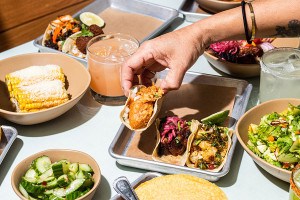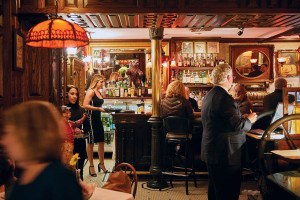Rebirth of the Cool: Heritage Reviewed

Beef tartare with green strawberry | Photo by Neal Santos
On the first day, there were Edison bulbs. Twenty-first-century diners across the land gazed up from rough-hewn farm tables, from their plates of artisanal charcuterie and pork belly with rich-yolked local egg, and beheld the bygone incandescence of the tungsten age.
On the second day, there were Clover Clubs and Aviations. Barmen wearing arm garters and handlebar mustaches shook Prohibition’s elixirs into the Facebook era.
Oh, but on the third day our souls willfinally sing, for the jazz club will rise again!
Nostalgia has gathered too much momentum, at any rate, for the wishful to abandon their hope. Jazz fans have known a decade of heartache in the city that produced John Coltrane, Clifford Brown, Lee Morgan, Jimmy Smith, McCoy Tyner, Christian McBride, and too many other giants to list. Names like Zanzibar Blue and Ortlieb’s Jazzhaus now ring with the poignancy of epitaphs. Yet as Stanley Crouch preached it, “There are some who do not accept the premature autopsy of a noble art form”—and 25 years after his sermon, Philadelphians have glimmers of a revival.
Heritage, which began mounting live jazz and funk seven days a week in April, is the latest. It’s the brainchild of Terrance Leach and Jason Evenchik, whose Time has helped foster a nascent jazz scene in that corridor east of Broad.
They’ve landed now in Northern Liberties, dreaming big. Chef Sean Magee’s menu is rich. The black-walnut bar runs a full 40 feet along a wall gushing with tropical shade plants. Skylights flood a soaring main room paneled with cedar, which also forms a spare, honey-colored bandstand at the far end.
In other words, this is not your standard-issue dank and smoky, bribe-the-fire-marshal juke joint. Cocktails take a backseat to 36 beer taps that burgeon with low-alcohol dazzlers—cider, gose, session saisons, Brett sours. And as for those Edison bulbs, Magee helped stuff them into the bells of a trombone and tenor saxophone and tack them onto tuba keys as part of a chandelier as riotous as an electrified Balkan brass band.
It’s not the only thing Magee has jolted with alternating current. His kitchen steers clear of hoary music-venue tropes— no soul food, pub grub or bistro standards here—opting instead for a headlong dive into the pig-head-torchon-with-fried-local-grains zeitgeist.
It’s not all that esoteric. The best French beans of the season, accessorized with a quail egg and fermented onion slivers, came traditionally dressed in a pickly, herbaceous sauce gribiche. A salad of golden Lancaster beets with baby mustard greens, red oak lettuce and parsley dispensed with the rote addition of goat cheese in favor of a dead-simple but stunningly good olive oil perked with lemon.
But for every small plate offering a safe pleasure, there was another bursting to make a statement. The coarse chop of Magee’s steak tartare amped up its wanton carnivorousness even as basil leaves and pickled green strawberries tricked the tongue down a garden path. Charcoal-grilled broccolini was slicked with a blockbuster black-garlic barbecue sauce and strewn with nubs of an ingeniously twisted house bacalao snatched from its cure at the halfway point and smoked for 12 hours— hands down, the most inspired brassica preparation in town. And Magee’s smoked cabbage, which accompanied a corned-beef-style sous-vide brisket, isn’t far behind.
Not every risk paid off. A tangy dusting of sumac couldn’t lift an unctuous foie gras mousse seeping into damp zucchini bread. Salt imbalances also dogged my first meal: too little on a fennel-and-chili bass crudo, way too much in the duck leg confit (which rocked on a subsequent night).
But I can’t wait to go back. Not just for the crafty menu. Not just for the overachieving beer list. And not just to hear James Santangelo’s piano trio glide through the chord changes on “Giant Steps.” Heritage’s alchemy is how all those things snap into harmony. Magee’s cooking is ambitious enough to draw jazz agnostics, which fosters a conversational vibe, which in turn gives succor to a music that’s always gained more from liveliness than reverence. The main room itself completes the magic: Encased in all that cedar, it somehow seems to preserve air- space for table talk even as it reverberates like another instrument in the band.
As a hungry barfly as much as a committed jazzhead, I would die to have a place like this in my neighborhood. Instead, I’ll just rejoice that it’s in my town.
Three Stars – Excellent
Heritage [Foobooz]
First published as “Rebirth of the Cool” in the September 2015 issue of Philadelphia magazine.


